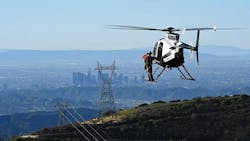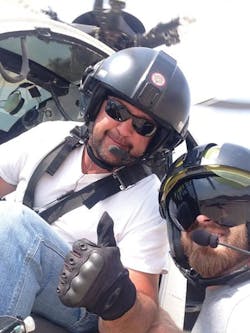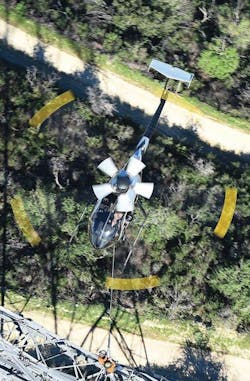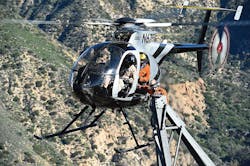Veteran Lineman Trades Climbing for Hovering
In his 24 years as a journeyman lineman, Wayne Temple has worked for municipalities and investor-owned utilities, and tramped through the hall. He has done everything from underground to distribution to transmission, to street lighting, substation and helicopter line work.
While working for an airborne power line contractor, however, his life changed forever. He is now one of the only linemen who carries his A-ticket and also serves as a wire pilot.
It all began when he was working as a lineman on the skid, and a pilot asked if he wanted to fly into the airport with him. Using the dual controls, the pilot showed him how to keep the helicopter straight and level.
The next thing he knew, he was helping to push the aircraft out of the hangar and fly to the job site. He worked all day as a lineman, and then at the end of the day, he would fly back to the airport with the pilot. Before returning home, however, he and the pilot would work on a different skill such as hovering the helicopter. After spending a year as a lineman on the skid, learning how to fly the MD500 in the wire environment and becoming a pilot, Temple decided to take the leap and start his own Denver, Colorado-based company — Wake Aviation, LLC.
“I never imagined that being a lineman would get me into flying helicopters, but you never know where the road is going to take you,” he says.
Working Out of a Helicopter
After working out in the field as a lineman and also learning how to fly a helicopter, Temple is now working with power companies worldwide to help them establish an in-house aviation department, acquire the necessary aircraft and set up the facilities.
In addition, Wake Aviation helps not only train the companies’ pilots to work in a line environment, but also teach the linemen how to work off of a helicopter. For example, the journeymen learn about landing zone safety through the eight-hour training course.
“Working out of a helicopter is much different than working out of a bucket truck,” Temple says.
With outages becoming increasingly harder to get, many of these journeymen work on energized systems, particularly when repairing or maintaining structures. With no path to ground, the linemen can safely work on live conductors without taking a costly outage.
From Lineman to Wire Pilot
Once the linemen have been trained, Temple transports them to their work locations on a skid or a long line.
As the linemen work out of the helicopter, Temple knows exactly which position they need to be in to do their work efficiently and safely. For example, if a lineman has to lift a conductor or pin an insulator to the steel, he can get in that spot and hover up and down four or five inches.
“If you ask most pilots about a dead-end shoe or a dampener, they won’t have a clue what you are talking about,” he says. “But before I became a wire pilot, I worked on the other end as a lineman, and I know exactly where they need to be when I set them on a structure and what they are working on.”
Because Temple is often in the pilot seat rather than on the tower, however, he doesn’t want to be the type of pilot who tells the journeymen how to do things. While he tries to help them out if they are in a bind, he says that in line work, there are 100 different ways to do the same job.
Temple, who has always loved helicopters, describes his job as a wire pilot as a “strange marriage between aviation and power lines.” When he was working as a journeyman lineman, he saw a YouTube video of a wire pilot, and he determined that he wanted to pursue that career path. He then worked his way up from a foreman to a superintendent to a director of operations to a wire pilot, and he says while he is glad he took advantage of this unique opportunity, he is also a lineman at heart.
“As proud as I am of being a business owner and a wire pilot, I’m more proud of being a lineman than anything,” Temple says. “I would go back in my hooks tomorrow and be just as happy. Twenty-four years of being a lineman, and I’ve loved every minute of it.”
Editor’s note: To see a video of Wayne Temple as a wire pilot, visit http://youtu.be/bFcbwIB_S5Q.
About the Author
Amy Fischbach
Electric Utilities Operations
Amy Fischbach is the Field Editor for T&D World magazine and manages the Electric Utility Operations section. She is the host of the Line Life Podcast, which celebrates the grit, courage and inspirational teamwork of the line trade. She also works on the annual Lineworker Supplement and the Vegetation Management Supplement as well as the Lineman Life and Lineman's Rodeo News enewsletters. Amy also covers events such as the Trees & Utilities conference and the International Lineman's Rodeo. She is the past president of the ASBPE Educational Foundation and ASBPE and earned her bachelor's and master's degrees in journalism from Kansas State University. She can be reached at [email protected].



